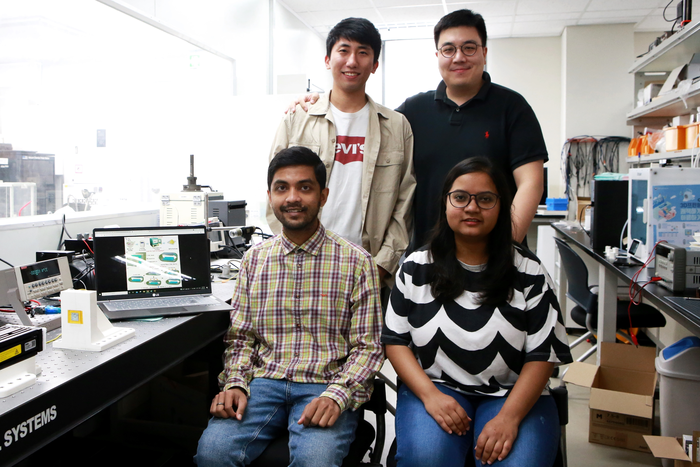Progress towards low-powered, energy-saving devices is keenly targeted by electronics industries. The transformation to low-powered LED lighting is an ideal example of this trend. Another option is the development of energy-harvesting, self-sufficient devices.
 (Clockwise from bottom right): Researchers Manisha Sahu, Sugato Hajra, Kyungtaek Lee along with Professor Hoe Joon Kim, who developed a composite film that can be used in energy harvesting generators. Image Credit: Daegu Gyeongbuk Institute of Science and Technology.
(Clockwise from bottom right): Researchers Manisha Sahu, Sugato Hajra, Kyungtaek Lee along with Professor Hoe Joon Kim, who developed a composite film that can be used in energy harvesting generators. Image Credit: Daegu Gyeongbuk Institute of Science and Technology.
The objective is to utilize materials that are capable of displaying piezoelectric and triboelectric effects to convert mechanical energy into electrical energy. Under mechanical stress, piezoelectric materials produce an electrical charge; meanwhile, the triboelectric effect is the build-up of charges on two dissimilar materials, post mutual contact.
The piezoelectric nanogenerators (PENG), triboelectric nanogenerators (TENG), and even hybrid piezo-triboelectric energy harvesters (HNG) that have enhanced energy harvesting capabilities have been developed to energize low-power electronics by simple motion.
This equipment usually needs dielectric materials that can retain their polarization and multiferroic materials that display ferromagnetic properties that are suitable for this task.
The study was published in the journal Nano Energy.
Collaborative research done by researchers from the Daegu Gyeongbuk Institute of Science and Technology (DGIST), Korea and the Indian Institute of Technology, Guwahati, India, has led to a composite film with potential application in combination with other materials to manufacture energy harvesting generators.
A cost-effective method was used to design the composite film, where a multiferroic material, bismuth titanate Bi4Ti3O12 (or BiTO), was introduced into a flexible triboelectric polymer (PDMS).
Our main motivation behind this work was to develop a room-temperature multiferroic material having high colossal permittivity for hybrid piezo-triboelectric energy harvester.
Hoe Joon Kim, Study Lead and Professor, Daegu Gyeongbuk Institute of Science and Technology
The researchers sandwiched the BiTO-PDMS between the aluminum layers to fabricate an HNG that can generate an electric charge when pressed and released.
The reason for the generation of current by these multiple layers lies in the characteristics of the film and its response to mechanical action. The layers serve as electrodes, and as the device is pressed and released, the piezoelectric and triboelectric natures of the film synergize with each other to produce charges on the electrodes, which creates a voltage.
The synergistic effect leads to improve energy harvesting performance. With the usage of several HNGs, the researchers were able to build a multi-unit HNG with the potential to power a wristwatch and a calculator.
For the first time, the single-phase room-temperature multiferroic material with colossal dielectric constant has been achieved. The internal polarization amplification of the polymer was improved, boosting the energy harvesting performance of the hybrid energy harvester.
Hoe Joon Kim, Study Lead and Professor, Daegu Gyeongbuk Institute of Science and Technology
As the work progresses to improvise the energy harvesting performance of nanogenerators, the minuscule devices can build the potential to invalidate batteries in several cases, making electronics that are more suitable and self-sufficient.
Journal Reference:
Hajra, S., et al. (2021) Lead-free flexible Bismuth Titanate-PDMS composites: A multifunctional colossal dielectric material for hybrid piezo-triboelectric nanogenerator to sustainably power portable electronics. Nano Energy. doi.org/10.1016/j.nanoen.2021.106316.